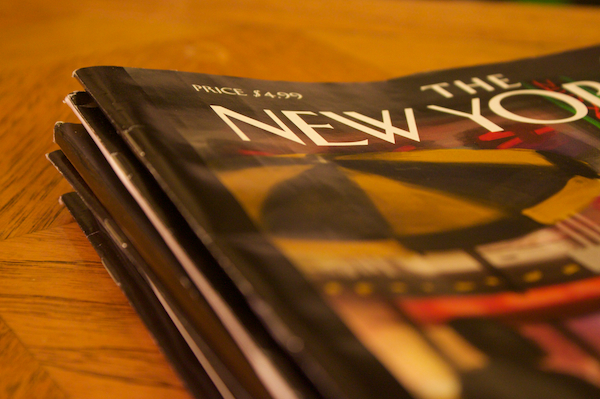The New Yorker on Tuesday launched The New Yorker Today, a smartphone app that gives the weekly magazine an up-to-the-minute digital jumpstart in a bid to attract new digital subscribers.
The app, which is available exclusively for iPhone, is being billed by The New Yorker as a “fast, simple way to get everything that The New Yorker produces—the magazine, the Web site, the videos, and the podcasts.” In a post heralding the app’s release, The New Yorker positioned The New Yorker Today as the latest step on the weekly magazine’s road to digital revolution:
Although our values and sense of rigor are unchanged, we’ve made every effort to embrace the technologies that make it easier for you to read and see our work. You can read us via Facebook or Twitter, or inside of Flipboard, or because someone sent you a link on WhatsApp. You can read us through our home page, or via an endless social-media stream. But, more and more, and wherever you are, you’re likely to be reading us on a mobile phone. In fact, one of our pleasant discoveries in recent years is that our readers will finish even our longest pieces—as much as ten and fifteen thousand words— on their phones.
The New Yorker Today, like the rest of The New Yorker’s products, aims to build subscribership by cultivating habitual users. The app is free to download and use for the first 30 days; thereafter, non-subscribers will be asked to pay a monthly fee of $8.99 for unlimited use. It’s reminiscent of The New Yorker’s metered paywall strategy, which has — somewhat counterintuitively — boosted Web traffic. It also comes on the heels of a 50 percent hike in The New Yorker’s yearly digital subscription price, to $89.99, which was prompted by a belief that New Yorker readers are somewhat indifferent to subscription costs.
Like most legacy organizations facing the inevitable decline of print advertising, The New Yorker is trying to generate a larger portion of its revenue from readers; today’s launch is another step in that direction. The magazine is wagering there’s an untapped audience of casual New Yorker readers who see a few articles on their phone through social media and mobile browsers who might be converted to paid subscribers with the right user experience.
“I think there are a lot of people who read our stories on their phones who haven’t subscribed yet,” said Nicholas Thompson, editor of New Yorker.com. “Our hypothesis is that if we create this app — if we create a really simple feed — people will test it out, they’ll come back, and they’ll find that they want to read 20 stories per month, or 30 stories per month, and then they’ll subscribe.”
Subscriber-focused news apps have struggled to gain traction with readers in the past. NYT Opinion, which was launched by The New York Times in June 2014 with a monthly price of $6, was shuttered after the app failed to find a substantial paying audience. The Times likewise transitioned NYT Now, its aggregation-focused news app, to a sponsorship model after its $8 monthly fee proved too high to attract a sizable audience.
Putting aside the idea of generating revenue, The New Yorker Today will add value for the magazine’s current subscribers, who may be seeking an easier way to read the magazine, Thompson said. And it’s an important step in the company’s ongoing bid to fashion itself into a modern media company.
“For 85 years or so, we’ve just been a weekly magazine,” Thompson said. “And gradually, we’ve become a whole lot of other things. We’ve become a website, we’ve become an radio show, we’ve become a TV show. And now we’ve become an app that includes the weekly magazine and all of the stuff we’ve just published today.”






